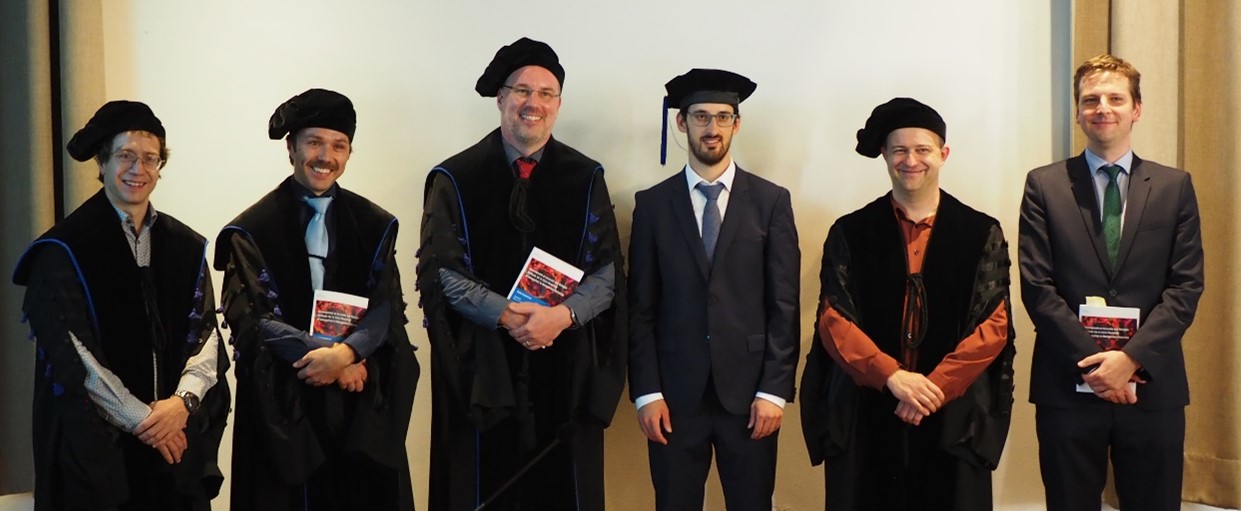During last summer four of our young researchers successfully defended their PhD. Underneath you find an overview of their research topics.
Congratulations Michael, Ruben, Liesbeth and Alexander!
Michael Freitas Gustavo
New tools for high-dimensional, expensive, black-box global optimization functions applied to ReaxFF parameterizations – Thursday June 29th, 2023
Supervisor: prof. Toon Verstraelen

Summary
This work is seized with improving methods for solving high-dimensional, expensive, and black-box (HEB) global optimizations; particularly in the context of ReaxFF parameterization. We broadly discuss the fundamental difficulties of such optimizations and the most recent algorithms in literature to tackle them. We illustrate how the parameterization of scientific empirical models is often an example of HEB optimization. Of particular interest for this work is the reactive force field, ReaxFF, which we discuss in the context of computational chemistry more broadly. Finding good parameters for ReaxFF force fields is an underserved but important area of study. As an improvement, we introduce an optimization framework, GloMPO, which uses a novel management and control structure to guide global optimization routines. We demonstrate that this approach, compared to standard optimizers, is able to identify better minima and makes more efficient use of computational resources. Due to its modular structure, GloMPO can be configured in many different ways and offers several qualitative advantages to practitioners. Next, we present a set of sensitivity analysis tools which identify the most important parameters of a ReaxFF loss function. The methods we use are based on the state-of-the-art Hilbert–Schmidt independence criterion (HSIC). The results allow users to identify insensitive parameters, and greatly reduce the dimensionality of the optimization problem. This allows optimizers to identify good parameter values, faster, and with less overfitting than without sensitivity treatment. Both of our toolkits have been fully integrated into publicly available commercial software. They have been shown to improve ReaxFF parameterizations and are also flexible enough to be applied to other HEB problems.
Ruben Goeminne
Development of accurate and reliable methods for in silico modeling of adsorption in nanoporous materials – Monday July 10th, 2023
Supervisor: prof. Toon Verstraelen

Summary
Metal-organic frameworks (MOFs) are a class of materials that have in recent decades attracted widespread scientific interest. When it became clear that these MOFs could maintain a permanent porosity and huge internal surface area, they were quickly identified as ideal materials for gas adsorption and separation applications. Most strikingly, applications such as the capture of carbon dioxide from industrial smokestacks or the production of water from desert air can be made possible by these materials. However, the gigantic structural diversity of these materials and their inherent flexibility complicates the experimental characterization of their adsorption properties. Therefore, in this doctoral research, advanced computational techniques were developed to computationally determine the adsorption properties of these materials. This work was approached in two ways. On the one hand, methods were developed to more accurately describe the interaction of adsorbates with these MOFs; both by improving traditional force fields, and employing machine learning techniques trained on highly accurate quantum mechanical calculations. On the other hand, methods were developed to efficiently predict the remarkable flexibility of these MOFs during gas adsorption.
Liesbeth De Bruecker
Spectroscopic Fingerprint of Electronic Excitations in Nanoporous Frameworks and Transition Metal Complexes – Tuesday August 29th, 2023
Supervisor: prof. Veronique Van Speybroeck

Summary
Electronic excitations are located in the ultraviolet and visible part of the electromagnetic spectrum. Using spectroscopy it is possible to study the interactions between electromagnetic waves and matter. However, this experimental technique does not always allow to fully unravel the spectra. To gain more insight, therefore quantum mechanical computational techniques based on density functional theory are used. In this doctoral thesis, the spectroscopic fingerprint of heterogeneous catalysts and transition metal complexes is studied. When looking for environmentally friendly catalysts, the study of electronic excitations can help to find suitable materials for specific applications. The spectroscopic properties of transition metal complexes can provide insight into the nucleation process of nanoporous lattices. This research shows that computer simulations can provide complementary information to experimental work, which ultimately leads to more efficient materials research.
Alexander Hoffman
Unraveling Phase Transformations and Reactivity in Functional Nanostructured Materials Using Computational Vibrational Spectroscopy – Thursday August 31st, 2023
Supervisor: prof. Veronique Van Speybroeck
Summary
Realizing sustainable solutions for societal challenges such as energy production, production of chemicals or capturing greenhouse gases requires the development of new materials with adapted functionalities. In that respect, functional nanostructured materials are very interesting, as their material properties, which strongly depend on the structure on an atomic scale, can be tailored to the specific application. Before these new materials can be used in practice, they must first be thoroughly characterized. To this end, a wide range of spectroscopic techniques are available that investigate the structure of materials through their interaction with radiation. The resulting energy spectrum is often complex, which means that the interpretation is not always obvious. To identify the different spectroscopic signals, molecular simulations that make it possible to understand the microscopic structure of the material are often used. In this PhD, such simulations are used to explain vibrational spectra of functional nanostructured materials with the ultimate goal of understanding the origin of phase transformations and chemical reactions.
